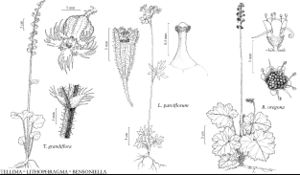Difference between revisions of "Lithophragma"
Fl. N. Amer. 1: 583. 1840, name conserved ,.
FNA>Volume Importer |
imported>Volume Importer |
||
| Line 132: | Line 132: | ||
|publication year= | |publication year= | ||
|special status= | |special status= | ||
| − | |source xml=https:// | + | |source xml=https://bibilujan@bitbucket.org/aafc-mbb/fna-data-curation.git/src/bb6b7e3a7de7d3b7888a1ad48c7fd8f5c722d8d6/coarse_grained_fna_xml/V8/V8_150.xml |
|genus=Lithophragma | |genus=Lithophragma | ||
}}<!-- | }}<!-- | ||
-->[[Category:Treatment]][[Category:Saxifragaceae]] | -->[[Category:Treatment]][[Category:Saxifragaceae]] | ||
Revision as of 00:08, 28 May 2020
Herbs, rhizomatous, not stoloniferous; caudex sometimes bearing bulbils. Flowering stems erect, leafy, 8–85 cm, stipitate-glandular. Leaves in basal rosette and cauline; cauline leaves (1–)2(–10), usually alternate (opposite in L. cymbalaria), unlobed, lobed, or palmately compound, sometimes with bulbils in axils; stipules present; petiole stipitate-glandular; blade rhombic or orbiculate to reniform, lobed, base cordate, hastate, rounded, ligulate, or cuneate, ultimate margins entire or toothed, apex obtuse or acute, surfaces often stipitate-glandular; venation palmate. Inflorescences compact or lax racemes, arising from axillary buds in basal rosette, 2–12(–25)-flowered, sometimes flowers solitary, (flowers sometimes replaced by bulbils), bracteate. Flowers: hypanthium partially adnate to proximal 1/2 to entire length of ovary, free from ovary 1–2 mm, green; sepals 5, green tinged with red; petals 5, white or pink; nectariferous tissue inconspicuous; stamens 10, (inserted on hypanthium, inner whorl attached proximal to point of petal insertion); filaments filiform; (anthers cordate); pistil 3-carpellate; ovary superior to 1/2 or almost completely inferior, 1-locular, carpels fully connate at ovaries; placentation parietal; styles 3; stigmas 3. Capsules 3-beaked. Seeds (50–200), usually dark brown, ovoid, smooth, wrinkled, or tuberculate. x = 7.
Distribution
w North America.
Discussion
Tellima R. Brown [unranked] Lithophragma Nuttall, J. Acad. Nat. Sci. Philadelphia 7: 26. 1834 (as Lithofragma); Pleurendotria Rafinesque, name rejected
Species 10 (10 in the flora).
Selected References
Lower Taxa
Key
| 1 | Leaves palmately compound, 3-foliolate; seeds spiny. | Lithophragma maximum |
| 1 | Leaves unlobed or lobed, or 3-foliolate; seeds smooth, wrinkled, tuberculate, or rough | > 2 |
| 2 | Stigma papillae in narrow subapical band; seeds smooth or wrinkled | > 3 |
| 2 | Stigma papillae covering apical surface; seeds tuberculate, tubercles in 3-19 rows, blunt or spinelike | > 6 |
| 3 | Leaf blades light green; cauline leaves 3-lobed, appearing pinnatifid; flowers persistent, slightly pendulous; racemes erect; petals 5-7-lobed; ovaries to 1/2 inferior. | Lithophragma tenellum |
| 3 | Leaf blades dark green or reddish green; cauline leaves 3-foliolate or 3-lobed; flowers deciduous if unfertilized, horizontal; racemes often lax, nodding; petals 3-lobed; ovaries 1/2+ inferior | > 4 |
| 4 | Hypanthia elongate-obconic, length 3-4 times diam.; petals pink; flowers fragrant. | Lithophragma trifoliatum |
| 4 | Hypanthia obconic to obconic-elongate, length 2 times diam.; petals usually white, sometimes pink; flowers not fragrant | > 5 |
| 5 | Cauline leaves 3-foliolate; hypanthia obconic-elongate; petals white or pink, often with prominent venation, 3-lobed, obovate-rhombic, widely spreading, ultimate margins entire; ovaries 1/2+ inferior. | Lithophragma parviflorum |
| 5 | Cauline leaves 3-lobed; hypanthia obconic; petals white with obscure venation, usually shallowly 3-lobed, ovate-elliptic, not widely spreading, ultimate margins sometimes with extra tooth, (lobes acute); ovaries ± completely inferior. | Lithophragma affine |
| 6 | Cauline leaves opposite (1 pair); flowering stems simple; petals unlobed, without serrations at base, ultimate margins entire. | Lithophragma cymbalaria |
| 6 | Cauline leaves alternate; flowering stems often branched; petals lobed or, if unlobed, margins sometimes with serrations at base | > 7 |
| 7 | Hypanthia broadly campanulate; flowers pendulous, petals partly included, ovate-elliptic, ultimate margins lacerate; flowers ± sessile. | Lithophragma campanulatum |
| 7 | Hypanthia narrowly campanulate; flowers horizontal, petals completely exserted, obovate-pandurate, ovate-elliptic, or ovate and palmately 5-lobed, ultimate margins entire; flowers long-pedicellate | > 8 |
| 8 | Hypanthia with truncate base; petals white, simple or 3-7-lobed; flowers not fragrant; racemes lax, nodding; cauline leaves 2-10; ovaries superior. | Lithophragma heterophyllum |
| 8 | Hypanthia with acute, obtuse, or hemispheric base; petals white or pink, unlobed, serrately 3-5-lobed, or 5-lobed; flowers sometimes fragrant; racemes erect; cauline leaves 2-4; ovaries to 1/2 inferior | > 9 |
| 9 | Plants usually robust; leaves usually unlobed or 3-5-lobed; petals white, unlobed or 3-5-lobed with serrations at base; inflorescences 2(-3)-branched, 3-5(-25)-flowered racemes, flowers rarely replaced with bulbils. | Lithophragma bolanderi |
| 9 | Plants usually fragile; leaves lobed (lobes rounded); petals usually pink, rarely white, palmately 5-lobed, base without serrations; inflorescences rarely branched (unless plant with bulbils), solitary flowers or 2-5(-7)-flowered racemes, often appearing corymbose; flowers sometimes replaced with bulbils. | Lithophragma glabrum |
